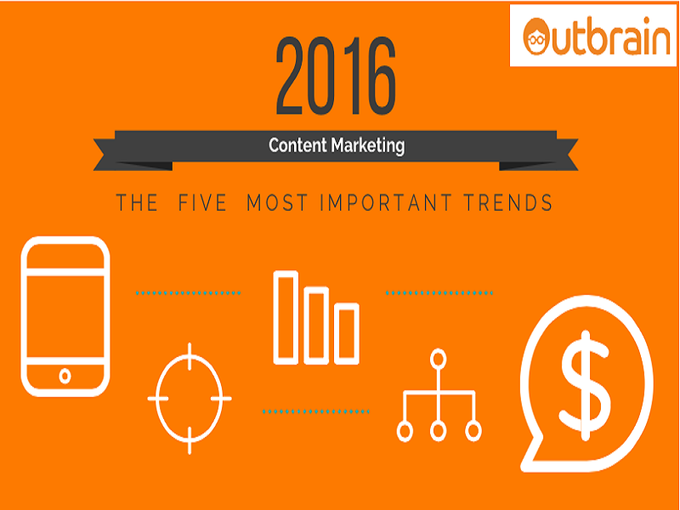 Gilad De Vries, senior Vice President of Strategy, who previously led the brands and agencies team at Outbrain and brings more than 19 years of experience in digital media and technology fields, says content marketing continued to evolve in 2015 and has become a “must-have” component in how brands execute their marketing strategy, especially in digital.
Gilad De Vries, senior Vice President of Strategy, who previously led the brands and agencies team at Outbrain and brings more than 19 years of experience in digital media and technology fields, says content marketing continued to evolve in 2015 and has become a “must-have” component in how brands execute their marketing strategy, especially in digital.He says “a true content marketing strategy is focused on adding value to the target consumer by delivering stories that make an impact on an emotional level and inspire and nurture them, as opposed to a typical advertising strategy which is all about persuasion and interruption.”
“A good content strategy can live for years, it’s not just a great campaign..” he adds.
As the man points out that most brands have just dipped their toes into the shallow end of the content marketing pool, and many are now ready to expand their efforts in a significant way, he takes us through the most important learnings from 2015 and upcoming trends going into 2016.
The Rise of the Specialist Content Marketing Agency:
Gilad writes in his Outbrain blog that Content marketing, known for its pull marketing model over push advertising, isn’t quick and easy to succeed with at scale.
“Getting started is hard and scaling velocity isn’t any easier. Currently, most traditional creative or media agencies are great at strategizing for push advertising purposes. With their big ideas, large campaigns and product promotions, they don’t really know how to develop a comprehensive content marketing strategy. But now, new kind of agencies are coming up which bring together a unique collection of skillsets with them like Strategy (to define the brand’s overarching content themes, target personas, value exchange, the right content mix), The definition of success (Goals, benchmarks, KPIs and how they will be measured), Creation (developing content at scale, Utilize content marketing platforms, Tech (to build and integrate technology platforms, analytics systems and marketing automation solutions), Media (to distribute content at scale for increased exposure and discovery); Data (to measure the success of the content program and help optimize all efforts like content creation, amplification efforts, engagement and shareability, conversions.”
Owned Content Gets More Focus
“I believe that as brands build their confidence in content marketing, they’ll start adopting more of an own rather than rent mentality. Ownership means hosting high-quality, interesting, educating, entertaining and inspiring content on a brand’s owned online properties,” he writes.
“That creates opportunities for Collecting associated data, not just summary reports; Building audience cookie pools for retargeting; Optimizing for engagement and conversions; Gaining SEO and organic sharing value; Building a CRM program for continuation of (free) messaging to audiences; Expanding strategy from providing informational value to utility value,” says Gilad De Vries.
A New Content Marketing Currency: CPE
“As marketers become more sophisticated about leveraging a multitude of platforms to drive content amplification (like Facebook, Twitter, Linkedin, Outbrain,
Tailoring Content For Different Platforms
Gilad further points out: “One size doesn’t fit all in content marketing and as brand managers and CCO’s (Chief Content Officers) get better at it, they’ve come to understand the need for different tones across platforms. Content cloning doesn’t necessarily strike a chord on each of the powerhouse platforms like Twitter, Facebook or
When looking at the content landscape, marketers need to carefully select the platforms they want to participate on and define a strategy for each. Some examples of the platforms and forums available for community building and distribution: Social Publishing: Pinterest, Instagram, Facebook, Twitter, Tumblr; Blog Publishing: Medium, LinkedIn; Video: Facebook, YouTube,
Content Immersion: The Content Experiences of Tomorrow
He writes: “The world of how we discover and engage with content is going to change drastically in the not so distance future. A world in which we read most (or all) of our news on our mobile devices, some of it projected as a hologram of a magazine. Real-time Persicope and Snapchat) and short form (Vine) will become a larger part of our daily content consumption. Virtual reality headsets will enable us to experience content as if it’s around us, not just as text or video in front of us. As consumption trends shift, brands will need to adopt their content strategy to include more immersive experiences. Some really great examples of this come in the form of virtual and augmented reality.”
In 2016, Gilad De Vries, suggests focusing your efforts on the following fronts:
Partner up: You can’t do everything yourself but you need to partner smartly with someone that’s an expert in pull marketing (and not in push advertising).
Own your content: Build your own content destination and make it useful / inspiring for your audience.
Improve engagement measurement: Create a common metric across all your acquisition and engagement efforts.
Content tailoring: Use the right kind of content for each discovery or amplification channel you want to use, considering if and why you might expand to new channels.
Plan for the future: Because it’s already here, so envision the content today that you’ll need to produce for the consumption of the future.
(Image credits: Outbrain)